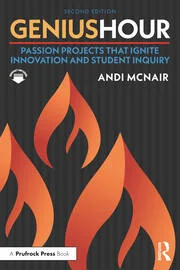Genius Hour Can Ignite Innovation and Inquiry
Genius Hour: Passion Projects that Ignite Innovation and Student Inquiry (2nd edition)
By Andi McNair
(Routledge/Prufrock 2022 – Learn more)
Reviewed by Stephanie Choate

The freedom to let students do whatever they want has led to so many questions: how much time do I give them? How do I grade them? Is it worth it? However, after years of experiencing students’ true passions the answer is always yes, it’s completely worth it.
This book is a perfect resource for someone trying to get a passion project off the ground, and it is also great for someone like myself, who is always looking for more ideas and resources to make the project the best it can be.
Why Passion Projects?

In a traditional classroom, a lot of decisions are made for the students: what they are learning, how they learn it, how they will be assessed. The Genius Hour approach gives students complete freedom to choose something they are passionate about (with a purpose) and reach a goal students set for themselves.
The Process
The book offers a detailed review of the process as well as its many benefits. The chapters are broken into each of McNair’s 6 Ps: passion, plan, pitch, project, product, and presentation. She explains each step, what students must do at each step, and the role of the teacher.
At the end of each chapter there are reflection questions for educators, quick tips on how to implement the ideas presented in the chapter, and a list of the digital resources related to the chapter. I found this super helpful as I want to go back and dive into each of the websites discussed and see where they can best fit into my project.
While the process itself is student driven and very different for each student, the benchmarks McNair offers as check-ins along the way (Major Moments) make keeping track of this daunting undertaking seem completely manageable. There are even handouts and digital resources she has used that can help you keep everything organized.
What Makes Genius Hour Standout
I was blown away by the fact that McNair was able to build a project like this for students that are so young! The products were thoughtful and quite impressive for elementary aged children, and it made me realize I can expect more from my 11th and 12th graders.
There were two steps of the process that I think make Genius Hour unique: finding experts and developing authentic audiences.
In the plan part of the project, students are asked to find an expert to help them with their project. McNair had her students make a Padlet with Google forms as a “Help Wanted” wall that she shared with her district and on other platforms. People would fill out the form if they were interested in helping with a certain project. This is a great way to build real-world connections and relationships, and McNair shares that it helps keep the students motivated.
McNair also talks about the importance of authentic audiences. Students must think about who their audience is (which is larger than just their classmates). For example, one student was creating new ice cream flavors, and they were going to share them with a local ice cream company. Pushing students to see the potential real-world impact of their projects is an excellent way to maintain motivation and excitement.
The Obstacles
While this book is definitely capable of setting you up for success, there are bound to be stumbling blocks along the way. Some students thrive on freedom, and others want the answers given to them. Some students know their passions and will remain locked-in and excited; others will lose steam along the way.
Therefore, after going through the process in detail, the final section of the book offers solutions to potential barriers and pitfalls. McNair shares the mistakes she made along the way and some ideas for avoiding her missteps. She includes how to best get buy-in from parents and administration. She also tackles grading, because even though she and I agree that the project shouldn’t be about the grade, many school systems are centered around a numerical grading system.
Learning through Application
Passion projects are the definition of hands-on learning. They allow students to organically learn research skills, improve their collaboration and communication skills, and meet learning standards in a variety of subject areas (depending on the project).
As educators, we are often stressed about fitting everything in. There is a finite amount of time to teach our students everything we think they need to know. I can admit, however, that my students may not remember the plot of a book I taught them, but they will never forget building their own guitar from scratch, writing a children’s novel, or choreographing their own dance.
Genius Hour can help an educator at any point in their journey open the door to creating innovative, student-led projects in their classrooms. One of the first steps, as McNair puts it, is letting go of the wheel and becoming the “passenger” in the car.
Stephanie Choate is the English Department Chair and a teacher at Austin Preparatory School. A lover of Shakespeare, rhetoric, and young adult literature, Stephanie facilitates workshops with the PD Collab, has presented at a Keeping the Wonder workshop, and is also a trained executive function tutor. You can find her work and book recommendations on her Instagram: @scarvesandseminars.



































Stephanie, great review of this honest look at Genius Hour! I was fortunate to participate in professional development a few weeks ago led by Andi McNair. I’ve always said that if you put GT students in a box, they are just going to want to jump out! The Genius Hour approach allows students to decide what shape, environment or measurement they want their box to be. By giving students the opportunity to use their creative skills and inquisitive minds, teachers are providing opportunities to apply and fuel their learning.